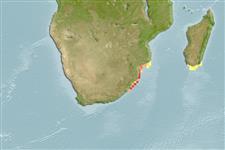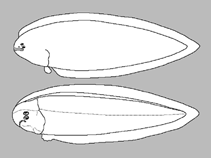Symphurus monostigmus Munroe, 2006
Spotbelly tonguefish
Добавить Ваши наблюдения в Fish Watcher
| Native range | All suitable habitat | Point map | Year 2050 |

|
| This map was computer-generated and has not yet been reviewed. |
| Symphurus monostigmus AquaMaps Data sources: GBIF OBIS |
Загрузить свой Фото и Видео
Изображение на GoogleNo image available for this species;
drawing shows typical species in Cynoglossidae.
Изображение на GoogleNo image available for this species;
drawing shows typical species in Cynoglossidae.
Классификация / Names народные названия | синонимы | Catalog of Fishes(род, виды) | ITIS | CoL | WoRMS | Cloffa
> Pleuronectiformes (Flatfishes) > Cynoglossidae (Tonguefishes) > Symphurinae
Etymology: Symphurus: Greek, syn, symphysis = grown together + Greek, oura = tail (Ref. 45335); monostigmus: Name from the Greek word 'manos' (= one) and 'stigma' (= spot), referring to the single, conspicuous, black spot on the anteroventral region of the ocular side of the abdomen.
Etymology: Symphurus: Greek, syn, symphysis = grown together + Greek, oura = tail (Ref. 45335); monostigmus: Name from the Greek word 'manos' (= one) and 'stigma' (= spot), referring to the single, conspicuous, black spot on the anteroventral region of the ocular side of the abdomen.
Environment: milieu / climate zone / depth range / distribution range экология
морской демерсальный; пределы глубины 65 - 110 m (Ref. 57441). Temperate
распространение страны | регионы FAO | Ecosystems | места находок | Point map | интродукции | Faunafri
Western Indian Ocean: South Africa.
Size / Вес / Возраст
Краткое описание определительные ключи | морфология | морфометрия
членистые (мягкие) лучи спинного плавника (общее число) : 86; членистые (мягкие) лучи анального плавника: 73 - 74; позвонки: 48. This species is distinguished by having an irregular, conspicuous, dark spot overlying the anteroventral ocular-side body cavity; a 1-2-2-2-2 ID pattern; caudal-fin rays 14; D 86; A 73-74; vertebrae, abdominal 9 (3 + 6), total 48; hypurals 5; longitudinal scale rows 92; transverse scale rows 36-38; scale rows on the head posterior to lower orbit 18-19; body deep (BD = 28.8-32.4% of HL); preanal length short (PAL = 21.3-25.5% of SL); upper head lobe much wider than lower lobe; head moderately short (HL = 18.0-20.2% of SL), with head length much shorter than head width (HW/HL = 1.38-1.42); postorbital length long (POL = 75.8-79.4% of HL); snout short (SNL = 13.6-14.8% of HL; SNL/ED = 1.08-1.25), rounded to obliquely blunt anteriorly; dorsal-fin origin at vertical at anterior margin of upper eye; predorsal length short (PDL= 16.4-19.3% of HL); eyes equal in position (anterior margin of upper eye equal with anterior margin of lower eye), or slightly subequal (with anterior margin of upper eye anterior to that of lower eye); no fleshy ridge on ocular-side lower jaw. Colouration: ocular-side pigmentation yellowish-white with numerous freckles along bases of dorsal- and anal-fin rays; blind-side pigmentation uniformly white; peritoneum bluish-black (Ref. 126065) .
Life cycle and mating behavior половая зрелость | размножение | нерест | икра | Fecundity | личинки
Основная ссылка
Upload your references | ссылки | координатор | соавторы
Munroe, T.A., 2006. New western Indian Ocean tonguefish (Pleuronectiformes: Cynoglossidae, Symphurus). Copeia 2006(2):230-234. (Ref. 57441)
Статус Красного Списка МСОП (Ref. 130435: Version 2024-2)
Нехватка данных (DD) ; Date assessed: 14 August 2019
CITES
Not Evaluated
Угроза для людей
Harmless
Использование человеком
FAO - Publication: search | FishSource |
дополнительная информация
Trophic ecology
пищевые объекты
состав пищи
потребление пищи
Food rations
хищники
пищевые объекты
состав пищи
потребление пищи
Food rations
хищники
Ecology
экология
экология
Population dynamics
Growth parameters
Max. ages / sizes
Length-weight rel.
Length-length rel.
Размерный состав
Mass conversion
пополнение
численность
Growth parameters
Max. ages / sizes
Length-weight rel.
Length-length rel.
Размерный состав
Mass conversion
пополнение
численность
Life cycle
размножение
половая зрелость
Maturity/Gills rel.
Fecundity
нерест
Spawning aggregations
икра
Развитие икры
личинки
динамика численности личинок
размножение
половая зрелость
Maturity/Gills rel.
Fecundity
нерест
Spawning aggregations
икра
Развитие икры
личинки
динамика численности личинок
Anatomy
жаберная область
Brain
Otolith
жаберная область
Brain
Otolith
Physiology
Body composition
Nutrients
Oxygen consumption
Swimming type
Swimming speed
Visual pigments
Fish sound
Diseases & Parasites
Toxicity (LC50s)
Body composition
Nutrients
Oxygen consumption
Swimming type
Swimming speed
Visual pigments
Fish sound
Diseases & Parasites
Toxicity (LC50s)
Genetics
генетика
Heterozygosity
наследуемость
генетика
Heterozygosity
наследуемость
Human related
Aquaculture systems
особенности рыбоводства
степень растяжения
Ciguatera cases
Stamps, coins, misc.
Aquaculture systems
особенности рыбоводства
степень растяжения
Ciguatera cases
Stamps, coins, misc.
инструменты
E-book | полевой определитель | определительные ключи | Длина-Частота | онтогенез | карта точек | Classification Tree
| Catch-MSY |
Специальные отчеты
Проверить содержание в аквариумах | Проверить опубликованные видовые данные | Проверить опубликованные данные по аквакультуре
Скачать в формате XML
ресурсы в Интернет
AFORO (otoliths) | Aquatic Commons | BHL | Cloffa | BOLDSystems | Websites from users | Проверить FishWatcher | CISTI | Catalog of Fishes: род, виды | DiscoverLife | ECOTOX | FAO - Publication: search | Faunafri | Fishipedia | Fishtrace | GenBank: Геном, Нуклеотид | GloBI | Google Books | Google Scholar | Google | IGFA World Record | MitoFish | Otolith Atlas of Taiwan Fishes | PubMed | Reef Life Survey | Socotra Atlas | Tree of Life | Wikipedia: Вперёд, поиск | World Records Freshwater Fishing | Zoobank | Zoological Record
Estimates based on models
Phylogenetic diversity index (Ref. 82804): PD50 = 0.5000 [Uniqueness, from 0.5 = low to 2.0 = high].
Bayesian length-weight: a=0.01072 (0.00507 - 0.02267), b=3.11 (2.92 - 3.30), in cm total length, based on LWR estimates for this (Sub)family-body shape (Ref. 93245).
Trophic level (Ref. 69278): 3.2 ±0.4 se; based on size and trophs of closest relatives
устойчивость к внешним воздействиям (Ref. 120179): высокий, минимальное время удвоения популяции до 15 месяцев (Preliminary K or Fecundity.).
Fishing Vulnerability (Ref. 59153): Low vulnerability (10 of 100).




